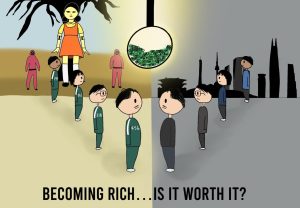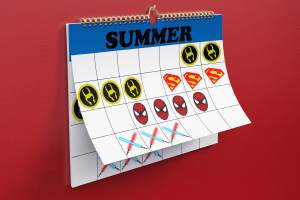‘What If…?’: High on Creativity, Short on Polish
The MCU’s inventive animated series is undercut by hasty plots and empty characters
“What If…?” is the first animated show from Marvel, and it has received a number of positive reviews.
October 30, 2021
Warning: Major spoilers from “What If…?”
The announcement of “What If…?” in 2019 came as a surprise. With this show being the first animated content from Marvel Studios, expectations from fans were very high. The trailers seemed interesting too, providing a fresh take on the 13-year-old franchise.
The newest Marvel series on Disney+, “What If…?” has received a lot of critical praise for its depiction of Marvel heroes in a collection of alternate realities called the multiverse. Critics and audiences rated the series 93% and 94% on Rotten Tomatoes, respectively. However, those who joined the massive consensus of positive reviews must have watched a version of the show from an alternate universe. In this reality, the series suffers from a myriad of problems that undercut its creative storylines.
Stories that would take an entire feature film to properly explore are crammed into 30-minute episodes.
Each of the 30-Minute Episodes Feel Rushed
“What If…?” often fails to capture the fun of previous Marvel content. This failure is partially due to the shorter format of the series. Stories that would take an entire feature film to properly explore are crammed into 30-minute episodes. This problem becomes exponentially worse in episodes with ensemble casts, where the altered backstories of many characters are barely mentioned.
Surprisingly, many of the actors in the Marvel Cinematic Universe (MCU) return to voice their characters. But the star-studded cast turns out to be a double-edged sword. Some of the performances fall flat, such as Mark Ruffalo’s turn as Bruce Banner. In the fifth episode, Dr. Banner encounters zombified versions of the Avengers, and repeatedly says “don’t eat me!” with the muted urgency of Willy Wonka at a workplace accident. However, there were voice actors that did a great job portraying the characters. Mick Wingert does a great job voicing Tony Stark by capturing the personality that many Marvel fans recognize from the films.
Heroic High Points of “What If…?”
The series starts strong with its first two episodes. “What If…?” swaps Captain America for Captain Carter in the series premiere. Hayley Atwell returns to voice Peggy Carter as she accepts the Super Soldier Serum after Steve Rogers is shot and injured by a Hydra agent. Bradley Whitford plays Colonel Flynn, whose misogyny makes Peggy Carter’s gender as much of a barrier to the frontlines of World War II as Steve Rogers’ frailty was in the original storyline of “Captain America: The First Avenger” (2011).
In the second episode, T’Challa takes on the mantle of Star Lord rather than Peter Quill. The late Chadwick Boseman voiced the character as he travels across the galaxy along with Yondu, the Ravagers and a version of Thanos who isn’t a genocidal villain. Both T’Challa and Peggy Carter’s stories show how heroes could have made a bigger impact if given the opportunity. It was genuinely exciting to see how these characters’ paths to heroism changed under different circumstances.
Meanwhile, the fourth episode puts a tragic twist on the story of Dr. Strange. Benedict Cumberbatch returns to voice Dr. Strange, who tries to bring his girlfriend, Christine Palmer, back from the dead. As the episode develops, Strange becomes more desperate to save Christine by using dark magic, which eventually turns the titular hero evil. Its focused plot helps viewers sympathize with Strange but also raises concerns since he keeps making the wrong decisions. Rather than relying on a typical victory for the superhero, I appreciate that the episode takes a different approach and concludes with Strange’s failure, leaving him to contemplate what went wrong.
The unique 3D artwork is made to look like it belongs in a comic book rather than a Pixar film.
In addition to these satisfying storylines, the show gets a lot right with the look and feel of the episodes. The unique 3D artwork is made to look like it belongs in a comic book rather than a Pixar film. For example, there is a shot in the eighth episode that shows Hawkeye sacrificing himself to help Natasha Romanoff and Arnim Zola stop Ultron. The sound design of the show anchors the series to the MCU by using authentic sounds for Mjolnir and Captain America’s shield.
It’s also fun to see dialogue between characters who haven’t interacted with each other in the MCU before. In the fifth episode, Peter Parker gives a heartfelt speech about perseverance to Hope Van Dyne, as their group struggles to survive a zombie apocalypse in their universe. Surprisingly, viewers are also given their first mention of Uncle Ben in the MCU, which makes them wonder if he will be mentioned again in future films. However, these highlights fail to overcome the cramped format of the show.
Poor Pacing Blurs the Moral of the Story
Think about all of the MCU movies and shows you’ve watched for over a decade. Have they changed you? Have these stories inspired you to be as brave as Steve Rogers, or as selfless as Tony Stark? For viewers who have enjoyed MCU storylines over the years, this series can be a form of self-reflection.
Should we maintain neutrality and watch as events unfold, or should we get involved and help to prevent the suffering of others?
The Watcher, who is played by Jeffrey Wright, narrates each episode from an omniscient perspective. Despite having god-like powers, the Watcher swears to never intervene in the events of any of the parts of the multiverse that he observes. He maintains his neutrality until he is directly attacked by a version of Ultron who gains the ability to travel between universes. The situation forces the Watcher to finally take action by forming the Guardians of the Multiverse to challenge Ultron.
The overarching story is a call to action. In truth, we, the audience, are the Watcher. The world is our multiverse. We watch scenes of catastrophe and social upheaval on the news every day. Should we maintain neutrality and watch as events unfold, or should we get involved and help to prevent the suffering of others? That is the central question that “What if…?” wants us to take on.
Unfortunately, this point hits with little effect, due mostly to the time constraints placed on the show. Perhaps there is another version of this show out there in the multiverse in which each episode is given more time to flesh out its plot. The version we got in this universe is a mixed bag of cool alternate storylines that are cut short. Since this is Marvel Studios’ first time making an animated series, we should hope that this season was just a test run and they will take advantage of the central question next season.














